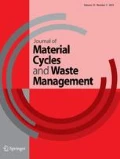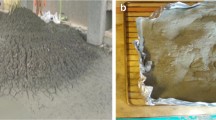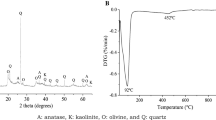Abstract
Dyeing sludge (DS) from textile industries are toxic in nature and have the potential to become a serious environmental burden for Bangladesh due to lack of safe disposal options. The huge brick manufacturing industry of Bangladesh is a potential avenue for sludge disposal as well as stabilization of DS through incorporation in clay bricks. We performed experiments to assess the engineering properties (strength, water absorption, firing shrinkage, weight loss on ignition and bulk density) of sludge-amended clay bricks manufactured in conventional kilns as well as to determine the leaching potential of toxic heavy metals from such bricks. Results of the tests indicated that the sludge proportion is the key factor in determining the brick quality. The compressive strength of DS bricks reduced from 24.5 to 9.93 MPa when DS content increased from 10 to 50%. Water absorption, weight loss in ignition and total shrinkage varied between 11.4% and 25.3%, 10.8% and 24.7%, 11.6% to 15.3%, respectively, for the same DS% range. 10% DS-amended kiln-manufactured bricks exhibited engineering properties which were superior to similar bricks tested in lab-scale studies and conformed to Grade A and S bricks as per Bangladesh Standard (BDS 208). 10% DS bricks also showed minimal loss during drying and burning in the manufacturing process. The TCLP test results indicated that the leaching concentrations of As, Cr, Cd, Cu and Pb from DS-amended bricks are far below the USEPA standard limits. Results from this study indicate that textile dyeing sludge can be sustainably stabilized in clay bricks manufactured in traditional brick kilns in Bangladesh.









Similar content being viewed by others
References
Adnan ATM, Rakib A, Rahman M (2015) Export trend of Bangladesh: the dominance of ready-made garment industry. Res J Econ Bus ICT 10:25–31
Bangladesh Country Snapshot (2015) The world bank group. https://100113-WP-PUBLIC-Box393225B-Bangladesh-Country-Snapshot.pdf. Accessed 1 Nov 2019
Masum M, Inaba K (2015) A comparative input-output analysis of the textile-clothing industry in Bangladesh and some Asian countries. Paper presented at 10th RICA conference, Bangkok, Thailand.
Islam MM, Halim MA, Safiullah S, Hoque SAMW, Islam MS (2009) Heavy metal (Pb, Cd, Zn, Cu, Cr, Fe and Mn) content in textile sludge in Gazipur Bangladesh. Res J Environ Sci 3:311–315
Kiron, M.I. (2015) Ready Made Garments Industry of Bangladesh. Bangladesh: A. Merchandiser. http://www.garmentsmerchandising.com/readymade-garments-industry-ofbangladesh/. Accessed 24 Mar 2019
Bangladesh Textile Today (2011) Why don't you be the first zero discharge textile industry of Bangladesh? Amin & Jahan Corp Ltd. https://www.textiletoday.com.bd/why-dont-you-be-the-first-zero-discharge-textile-industry-of-bangladesh/. Accessed 1 Nov 2019
Touhid BA, Bushra B, Shoeb A (2018) Utilization of textile sludge and public health risk assessment in Bangladesh. Sust Environ Resear 28(5):228–233
Waste Concern (2009) Waste database of Bangladesh. Dhaka Bangladesh.
Manahan SE (2005) Environmental chemistry, 8th edn. Lewis Publisher, Boca Raton
Wilson B, Pyatt FB (2007) Heavy metal dispersion, persistence, and bioaccumulation around an ancient copper mine situated in Anglesey. UK Ecotoxicol Environ Saf 66:224–231
Singh KP, Mohan D, Sinha S, Dalwani R (2004) Impact assessment of treated/untreated wastewater toxicants discharged by sewage treatment plants on health, agricultural, and environmental quality in the wastewater disposal area. Chemosphere 55:227–255
Alom MM (2016) Effects on environment and health by garments factory waste in Narayanganj city Dhaka. Am J Civ Eng 4:64e7
Meenakshipriya B, Saravanan K, Shanmugam R, Sathiyavathi S (2008) Study of pH system in common effluent treatment plant. Mod Appl Sci 2:113e21
Iqbal A, Salma, Kabir F, Quader AKMA, Mahmud I (2013) Thermal treatment of textile sludge. 10th international conference on mechanical engineering, ICME. Procedia Eng 90:686–691.
Abed M, Hossain (2004) Stabilization of heavy metals in industrial sludge with concrete Mix. MSc. Engineering Thesis, Civil Engineering Department Bangladesh University of Engineering and Technology Dhaka
Swarnalatha S, Ramani K, Karthi AG, Sekaran G (2006) Starved air combustion-solidification/stabilization of primary chemical sludge from a tannery. J Hazard Mater 137:304–313. https://doi.org/10.1016/j.jhazmat.2006.02.006
Kirk DW, Chan CCY, Marsh H (2002) Chromium behavior during thermal treatment of MSW fly ash. J Hazard Mater 90:39–49. https://doi.org/10.1016/S0304-3894(01)00328-4
Rouf MA, Hossain MD (2003) Effects of using arsenic-iron sludge wastes in brick making. F Arse Environ 34(6):193–208
Hossain MA (2004) Stabilization of industrial sludge with concrete mix MSc. Engineering Thesis, Department of Civil Engineering, BUET, Dhaka.
Basegio T, Berutti F, Bernardes A, Bergmann CP (2002) Environmental and technical aspects of the utilisation of tannery sludge as a raw material for clay products. J Eur Ceram Soc 22:2251–2259. https://doi.org/10.1016/S0955-2219(02)00024-9
Zhuqing D, Yunqiu W, Linchao H, Wenyi Z, Linqiang M (2019) Evaluating physical-mechanical properties and long periods environmental risk of fired clay bricks incorporated with electroplating sludge. Constr Build Mater 227:116716
Baskar R, Meera Sheriffa Begum KM, Sundaram S (2006) Characterization and reuse of textile effluent treatment plant waste sludge in clay bricks. J Univ Chem Technol Metall 41(4):473–478
Balasubramanian J, Sabumon PC, Lazar JU, Ilangovan R (2006) Reuse of textile effluent treatment plant sludge in building materials. Waste Manag 26:22–28
Jahagirdar S, Shrikant SS, Manu B (2012) Reuse of textile mill sludge in cement based solid blocks. Int J Engg Research and Indu Appls (IJERIA) 5:213–224
Jahagirdar S, Shrihari S, Shrikant S, Manu B (2013) Reuse of textile mill sludge in burnt clay bricks. Int J of Adv Technol Civil Eng 2(1):96–99
Juel AI, Al M, Tanvir A (2016) Sustainable use of tannery sludge in brick manufacturing in Bangladesh. Waste Manag 60:259–269
DoE (2015) Standards and guidelines for sludge management. Department of Environment, Dhaka (978-984-34-0858-7)
World Bank (2011) Introducing energy-efficient clean technologies in the brick sector of Bangladesh. World Bank Group. http://documents.worldbank.org/curated/en/770271468212375012/Introducing-energy-efficient-clean-technologies-in-the-brick-sector-of-Bangladesh. Accessed 1 Nov 2019
BS 1377-2 (1990) Methods of test for soils for civil engineering purposes. Part 2: classification tests. British Standards Institution, London, England
AASHTO T 99-19 (2019) Standard method of test for moisture-density relations of soils using a 2.5-kg (5.5-lb) Rammer and a 305-mm (12-in.) drop. Standard Specifications for Transportation Materials and Methods of Sampling and Testing, and AASHTO Provisional Standards, American Association of State Highway and Transportation Officials, Washington, DC
ASTM D 4318 standard test methods for liquid limit, plastic limit, and plasticity index of soils. West Conshohocken, PA, 2000 19428-2959, United States. doi:10.1520/D4318
Aziz MA (1995) Engineering materials. Hafiz Book Centre, Dhaka, Bangladesh
ASTM C67 / C67M-20 (2020) Standard test methods for sampling and testing brick and structural clay tile. ASTM International, West Conshohocken, PA, United States. https://doi.org/10.1520/C0067_C0067M-20
ASTM D2974-14 (2014) Standard test methods for moisture, ash, and organic matter of peat and other organic soils. ASTM International, West Conshohocken, PA, United States. https://doi.org/10.1520/D2974-14
ASTM C210–95 (2019) Standard test method for reheat change of insulating firebrick. ASTM International, West Conshohocken, PA, United States. https://doi.org/10.1520/C0210-95R19
ASTM C20–00 (2015) Standard test methods for apparent porosity, water absorption, apparent specific gravity, and bulk density of burned refractory brick and shapes by boiling water. ASTM International, West Conshohocken PA, United States. https://doi.org/10.1520/C0020-00R15
USEPA Test Method 1311 (1996) Toxicity characteristic leaching procedure. In: Test methods for evaluating solid waste. Laboratory manual: Physical/chemical methods. SW-846. U.S. Environmental Protection Agency, Office of Solid Waste and Emergency Response, Washington, DC, 1996.
Panjaitan SRN (2014) The effect of lime content on the bearing capacity and swelling potential of expansive soil. J Civ Eng Res 4:89–95. https://doi.org/10.5923/c.jce.201402.15
Liew AG, Idris A, Samad AA, Wong CHK, Jaafar MS, Baki AM (2004) Reusability of sewage sludge in clay bricks. J Mater Cycles Waste Manag 6:41–47. https://doi.org/10.1007/s10163-003-0105-7
Patel H, Pandey S (2009) Exploring the reuse potential of chemical sludge from textile wastewater treatment plants in India—a hazardous waste. Am J Environ Sci 5(1):106–110
Rahman MM, Khan MMR, Uddin MT, Islam MA (2017) Textile effluent treatment plant sludge: characterization and utilization in building materials. Arabian J Sci Eng 42:1435–1442
Hassan KM, Fukushi K, Turikuzzaman K, Moniruzzaman SM (2014) Effects of using arsenic-iron sludge wastes in brick making. Waste Manag 34:1072–1078. https://doi.org/10.1016/j.wasman.2013.09.022
Begum SSB, Gandhimathi R, Ramesh ST, Nidheesh PV (2013) Utilization of textile effluent wastewater treatment plant sludge as brick material. J Mater Cycles Waste Manage 15:564–570
Ukwatta A, Mohajerani N, Eshtiaghi S, Setunge S (2016) Variation in physical and mechanical properties of fired-clay bricks incorporating ETP biosolids. J Clean Prod 119:76–85
ASTM C 62 Standard specification for building brick (Solid Masonry Units Made from Clay or Shale). West Conshohocken, PA, 2012 19428–2959, United States
BDS 208 (2009) Specification for common building clay bricks (Third revision) Specifies the dimensions, quality and strength of common burnt clay bricks, methods of sampling, testing etc
Weng C-H, Lin D-F, Chiang P-C (2003) Utilization of sludge as brick materials. Adv Environ Res 7:679–685
Chiang KY, Chou PH, Hua CR, Chien KL, Cheeseman C (2009) Lightweight bricks manufactured from water treatment sludge and rice husks. J Hazard Mater 171:76–82. https://doi.org/10.1016/j.jhazmat.2009.05.144
Karaman S, Gunal H, Ersahin S (2006) Assessment of clay bricks compressive strength using quantitative values of colour components. Constr Build Mater 20:348–354. https://doi.org/10.1016/j.conbuildmat.2004.11.003
Rhodes D, Hopper R (2000) Clay and glazes for the potter. Krause Publications, Wisconsin
Bhatnagar JM, Goel RK (2002) Thermal changes in clay products from alluvial deposits of the Indo-Gangetic plains. Constr Build Mater 16:113–122. https://doi.org/10.1016/S0950-0618(01)00031-9
Goel G, Kalamdhad AS (2017) An investigation on use of paper mill sludge in brick manufacturing. Constr Build Mater 148:334–343
Author information
Authors and Affiliations
Corresponding author
Additional information
Publisher's Note
Springer Nature remains neutral with regard to jurisdictional claims in published maps and institutional affiliations.
Electronic supplementary material
Below is the link to the electronic supplementary material.
Rights and permissions
About this article
Cite this article
Ullah, S.M.H., Hasan, M., Ahmad, S.I. et al. Performance of industrial sludge-amended bricks manufactured in conventional kilns. J Mater Cycles Waste Manag 22, 1932–1942 (2020). https://doi.org/10.1007/s10163-020-01080-9
Received:
Accepted:
Published:
Issue Date:
DOI: https://doi.org/10.1007/s10163-020-01080-9




